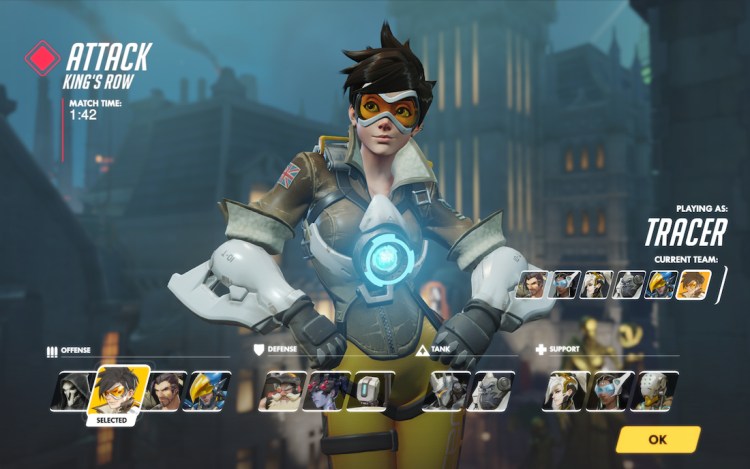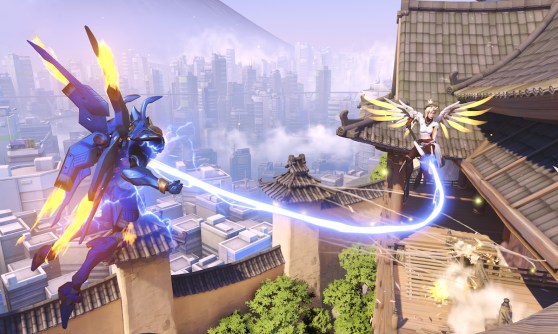The biggest stars at this year’s BlizzCon event had nothing to do with space aliens or the denizens of Azeroth. A bespectacled gorilla with a lightning gun and a cheery, time-traveling English soldier stole the show.
At its annual fan convention, developer Blizzard Entertainment announced Overwatch, its first new game in 17 years that isn’t a part of its Warcraft, StarCraft, or Diablo franchises. Overwatch is a team-based multiplayer shooter for PC that has a variety of superpowered characters to choose from (12 heroes were available to play at BlizzCon, and Blizzard promised it’s working on adding several more). The company wasn’t ready to talk about how it’s going to sell Overwatch just yet, but it did say a beta is coming in 2015.
I was at BlizzCon all weekend long and spent as much time as I could (10 multiplayer rounds, to be exact) with Overwatch. Even in my post-convention haze — my back hurts from carrying my laptop, and my hearing hasn’t been the same since the Metallica concert — I’m still thinking about this game a lot. Here are a few things I learned from playing.
What a Blizzard-made first-person shooter feels like
Blizzard is mostly known for its expertise in the real-time strategy, role-playing, and massively multiplayer online genres, so its take on FPS games is fascinating in and of itself. And this shooter moves pretty damn fast. You can take down most of the heroes with just a few shots, and when you die, it doesn’t take long for Overwatch to pull you back into the fight. Death also gives you the opportunity to change into another hero if you didn’t like your last choice.
Overwatch does require a bit of multitasking because movement (more on that later) is quite different from other multiplayer games, and it took some time for me to wrap my head around the heroes’ special abilities. The 6-on-6 battles can get chaotic, but once I knew what I was doing, I couldn’t wait to jump into another match and experiment with the other characters.
Shooters don’t always have to be so violent
I’m so used to violent multiplayer games that it took me a while to realize that Overwatch’s use of blood is very minimal. At first, I thought that it had none since I didn’t notice it in my play sessions (I realized I was wrong after looking at some gameplay footage again). You do see some blood splatter here and there, but it’s a cartoonish kind of violence, so it’s not like heads and limbs are falling off players’ bodies.
This fits well with the game’s uplifting tone. At Overwatch’s inaugural BlizzCon panel, the developers said they wanted to build a world that was worth fighting for, a place that players wanted to come back to again and again. So instead of seeing war-torn battlefields, you’ll find maps that are beautiful renditions of familiar real-world locales filtered through Overwatch’s version of the future. Some of the characters also reflect this upbeat attitude in their dialogue: Mercy, a healer who can fly for a brief period of time, even says “Heroes never die!” while in battle.
You’re still killing each other, so the game isn’t about holding hands and making friends with your enemies. But seeing such positivity in a shooter is refreshing and most importantly, still a lot of fun. The level of gore could change over the course of Overwatch’s development, but I have a feeling Blizzard is going to keep the buckets of blood away from this one.
It breaks the 2014 jetpack trend
This year’s crop of triple-A multiplayer games — Titanfall, Destiny, and Call of Duty: Advanced Warfare — all have one thing in common: jetpacks (or some variation of it). They allow players to make huge leaps or double-jump to the top floors of a building to avoid gunfire. Apparently, Overwatch didn’t get the memo. It doesn’t even have a “sprint” button, so unless your character has a fancy ability to make up for it (teleportation, flight, wall-climbing, grappling hooks, etc.), they have to move the old-fashioned way.
It’s not necessarily a bad thing, but it is different and makes your hero choices more meaningful. In general, the most agile characters are also the weakest when it comes to health.
Know your role
A functioning team is the key to winning in a lot of multiplayer games, but because Overwatch’s heroes fall into such rigid classes (offense, defense, tanks, and support), teamwork is especially vital here. Being on a good team can lead to quick and decisive victories, so recognizing the strengths and weaknesses of your hero goes a long way. For example, I wasn’t helping anyone when I kept running into the front lines as Symmetra, a support character with a small amount of health. Her play style requires a lot of patience, and I should’ve let my teammates clear a path before going in.
A few heroes feel too fragile
I understand why the support class is a little vulnerable, but I found it strange that offensive characters also don’t have much health. I first noticed this when I played as Hanzo. The Japanese archer kind of acts like a sniper, so you have to pick your targets (and sniping spots) carefully. Like a dummy, I stayed in the open while I experimented with Hanzo’s attacks, and I was a little annoyed when I found out he can die rather quickly.
I hope Hanzo and others get a health boost at some point. In the demo, the only way to attack players without worrying too much about your health was with damage-absorbing tanks like Reinhardt (the big knight) and Winston (the gorilla).



